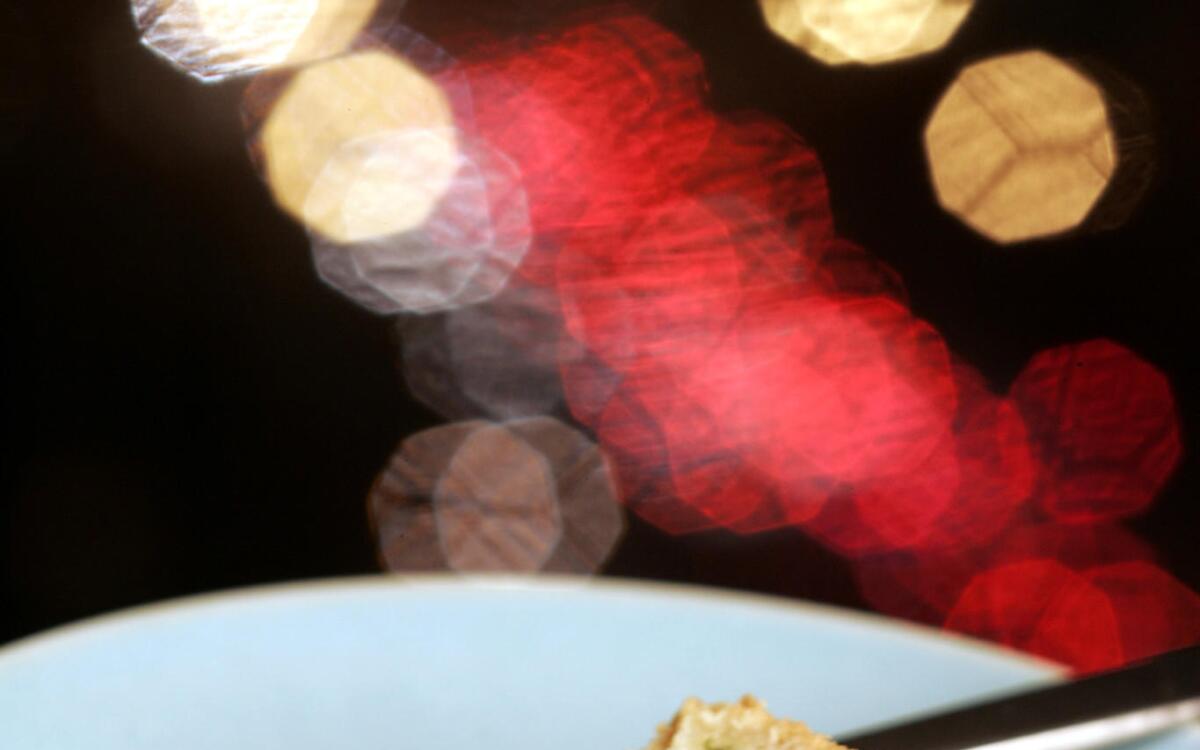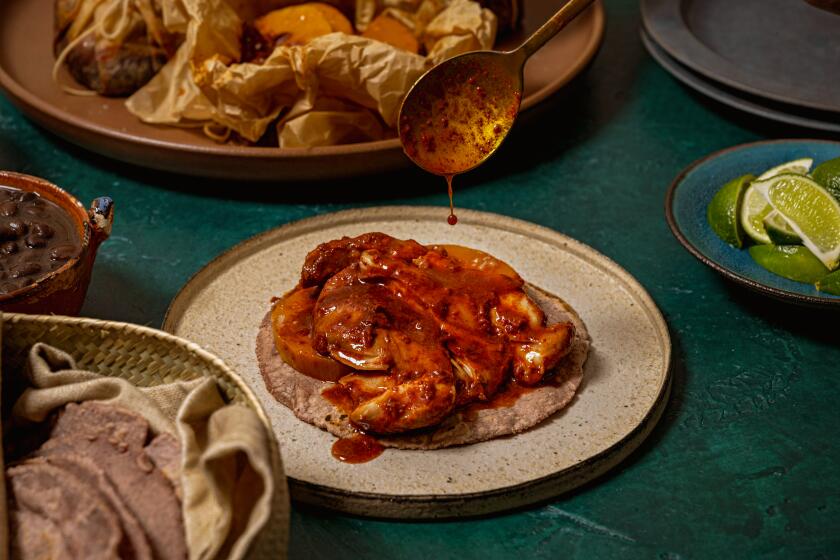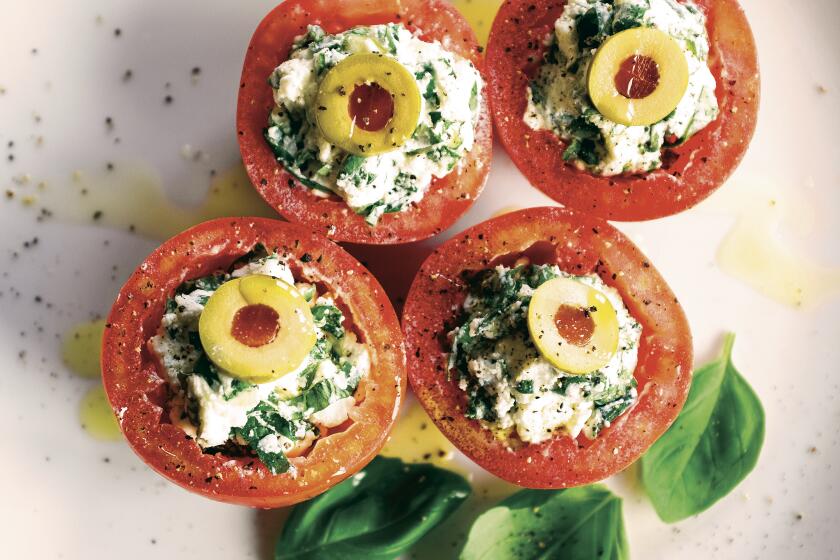Tart of mixed greens

- Share via
Keep your ribbons and your bows, your stockings hung by the chimney with care. When it comes to the holidays, what I really want is an open house.
All year long we have dinner parties, pretty quiet affairs usually, maybe six or eight friends sitting around enjoying food, wine and polite conversation. But at the holidays we really cut loose, filling the house so full with people we care about that it seems close to bursting.
And though the conversation may be a little loud to be considered strictly polite, the food had still better be great.
The trick is getting all those people served. I’ve got a one-word answer: buffet. I know, the word makes you think of all-you-can-eat and Vegas. But buffet is nothing but a style of service, and, properly carried out, it can be about as elegant as any meal you’ve ever served.
All it takes is a little strategizing to get things right. But the payoffs are worth that small extra effort. Primary among them is that you, the cook, are freed from most kitchen duties once the guests arrive. Arrange the food on platters and in bowls, set them in the appropriate spots and except for periodic refreshing and neatening, you’re pretty much done. You can enjoy the party too.
The key to a good buffet is an irresistible feeling of abbondanza. Think of the first time you walked into an Italian restaurant and saw a real antipasto table -- the colors, the textures, the promise of all those flavors. It’s dazzling; your spirit lifts just looking at it. That’s the kind of effect you want to have.
Start with the centerpiece. Though one main course is enough for most dinner parties, with buffets, you’re better off planning in multiples.
A roast tenderloin of beef is about as impressive a centerpiece as you could want, particularly if you serve it with something such as a tart, slightly spicy horseradish creme fraiche (resist any thoughts of serving it with a jus or other sauces -- when they cool, they become unpleasant). Though roast tenderloin is about as close to a guaranteed showstopper as you can get, there are few things simpler to prepare -- season, sear and roast. There’s nothing more to it.
But not everyone eats beef (and at $15 a pound and more, it gets a little expensive for a crowd). So supplement it with a brined and roasted turkey breast. Or pick up a side of salmon and oven-poach it (bake it in a 300-degree oven over a baking pan of boiling water for 25 to 30 minutes -- you won’t believe how moist and buttery it turns out). The same horseradish sauce will work for either.
A deep-dish vegetable tart will do double duty, working as an appetizer and a main course for vegetarians. Once you’ve prepared the dough and stir-fried the greens (things that can be done a day ahead), it comes together easily: Combine the vegetables, ricotta and eggs and bake them in a crisp pastry crust.
Then there’s the whole salad paradox. On the one hand, especially in the midst of the holiday food-a-thon, there are few things more welcome than a dish that is crisp and light. But most lettuces will go limp almost as soon as they are dressed; forget about them lasting an hour or more.
Sturdy greens such as endive, radicchio and watercress will keep their crunch longer. These salads can be simple -- just greens and a dressing -- or they can be complex. Combine endive and watercress and top with buttery avocado and the sweet meat of a Dungeness crab and you’ve got another main dish.
Cabbage is another salad solution. Though you may not want to serve your Fourth of July picnic coleslaw at Hanukkah-time, you’d be surprised how elegant Nappa cabbage can be if dressed simply with rice vinegar and a little sesame oil and then tossed with chopped cilantro and toasted sesame seeds just before serving.
Or treat cooked vegetables as salads. In fact, there’s nothing more joyfully Californian than turning your holiday buffet table into a farmers market stand. Blanch broccoli or cauliflower, and toss it with a piquant anchovy vinaigrette. Dress green beans with olive oil, lemon and garlic. Combine roasted beets with their blanched greens, toasted walnuts and some crumbled fresh goat cheese. Gently stew leeks until they’re tender, then let them cool in a mustardy vinaigrette.
Glazed vegetables are good too. Cut vegetables into small pieces and cook them, covered, over medium heat with a little water and a little fat until they’re just becoming tender. Remove the cover and increase the heat to high. The water will evaporate, leaving the vegetables covered in a savory glaze.
There are all kinds of twists to this: Glaze Brussels sprouts in bacon fat and add crunchy hazelnuts for texture. Glaze pearl onions with butter and minced tarragon. One of my favorite combinations is glazing carrots with orange juice and just a hint of pimenton de la vera, Spanish smoked paprika. Toss in some toasted slivered almonds and minced parsley just to warm through.
All of this sounds like a lot of work, and if you tried to do it all yourself, it would be. The secret is to pick your spots and fill in the gaps with good-quality prepared food.
Remember, this open house is your holiday gift too.
Tart shell
Place 1 cup of the flour and the salt in the bowl of a mixer fitted with the paddle attachment. Turn to low speed and add a small handful of the butter at a time. When all the butter has been added, increase speed to medium and mix until the butter is completely blended with the flour. Reduce the speed, add the remaining flour, and mix just to combine. Slowly add the water and mix until incorporated. The dough will come around the paddle and pull cleanly away from the sides of the bowl. It should feel smooth, not sticky.
Remove the dough from the mixer and check to be certain that there are no pieces of butter remaining; if necessary, return the dough to the mixer and mix briefly again. Pat the dough into a 7- to 8-inch disk and wrap in plastic. Refrigerate for at least 1 hour or up to a day.
Lightly brush the inside of an 8-by-2-inch-high springform pan with canola oil and place it on a jellyroll pan. Place the dough on a floured surface and rub all sides with flour. Flatten it into a larger circle using a rolling pin or the heel of your hand. Roll out the dough into a circle about one-fourth inch thick and about 14 inches in diameter. (If the dough becomes very soft, refrigerate for a few minutes.)
To lift the dough into the springform pan, place the rolling pin across the bottom edge and roll it up on the pin. Carefully lower it into the pan, pressing it gently against the sides and into the bottom corners. Trim any that extends more than an inch over the sides and reserve the scraps. Fold the excess dough over against the outside of the ring. (Preparing the tart shell this way will prevent it from shrinking down the sides as it bakes. The excess dough will be removed after the tart is baked.) Carefully check for any cracks or holes in the dough, and patch with the reserved pieces as necessary. Place in the refrigerator or freezer for at least 20 minutes to resolidify the butter. Reserve the remaining dough scraps.
Set a rack in the middle of the oven and heat to 375 degrees. Line the tart shell with an oiled 16-inch round of parchment paper or aluminum foil. Fill the shell with pie weights or dried beans, gently guiding the weights into the corners of the shell and filling the shell completely. Bake the shell until the edges of the dough are lightly browned but the bottom is still light in color, 35 to 45 minutes.
Carefully remove the parchment and weights. Check for any cracks or holes and patch with thin pieces of the reserved dough, if necessary. Return the shell to the oven until the bottom is a rich golden brown, 15 to 20 minutes. Remove from the oven and prepare to fill immediately. Once again, check the dough for any cracks or holes, and patch if necessary before filling with the greens mixture. Leave the oven on.
Filling and assembly
While the tart shell is baking, heat the olive oil over medium-high heat in the largest saute pan you own. When the oil is hot, begin adding the greens, a couple of handfuls at a time and stir-frying them until they begin to wilt, about 3 minutes. When one batch of green has wilted, add more and continue cooking until all of the greens have been cooked, about 12 to 15 minutes in all. Reduce heat to low, add the green onions and minced garlic and season with 1 teaspoon salt. Cook until the garlic softens and becomes fragrant, about 5 minutes. You will have about 3 to 4 cups of cooked greens.
Transfer the greens to a food processor and pulse 2 to 3 times to mince. Add the ricotta, goat cheese, half-and-half, one-fourth teaspoon salt, black pepper and nutmeg and pulse until thoroughly mixed. Taste and adjust seasoning. Add the eggs and pulse to combine thoroughly.
Pour the filling into the baked tart shell. Sprinkle the Parmesan evenly over top. Bake at 375 degrees until the tart is puffed in the center and golden on top, about 1 hour. A knife inserted in the center should come out clean.
Set the tart aside to cool at least 30 minutes before serving at room temperature. Remove any overhanging dough, using a serrated knife. Gently free the springform pan and remove the outer ring. (This dish can be prepared 1 day ahead, cooled completely, covered tightly with aluminum foil and refrigerated. Reheat in a 350-degree oven before serving.)
Get our Cooking newsletter
Get a taste of Los Angeles — and the world — with recipes and kitchen tricks from the L.A. Times’ Cooking newsletter.
You may occasionally receive promotional content from the Los Angeles Times.
















